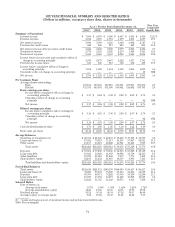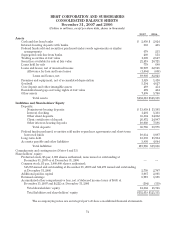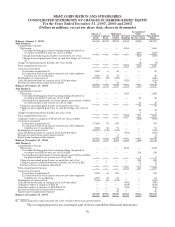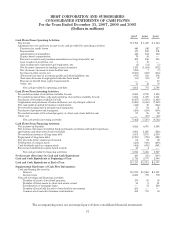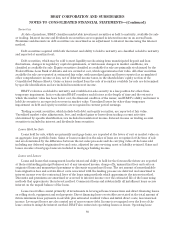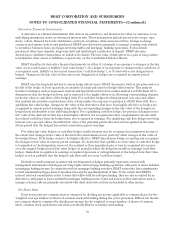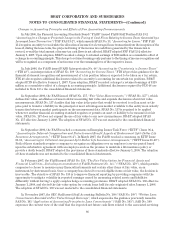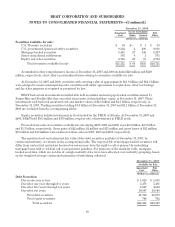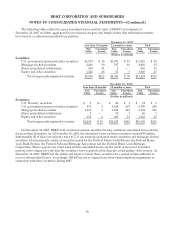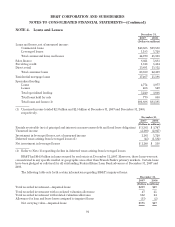BB&T 2007 Annual Report Download - page 81
Download and view the complete annual report
Please find page 81 of the 2007 BB&T annual report below. You can navigate through the pages in the report by either clicking on the pages listed below, or by using the keyword search tool below to find specific information within the annual report.BB&T CORPORATION AND SUBSIDIARIES
NOTES TO CONSOLIDATED FINANCIAL STATEMENTS—(Continued)
equipment is carried at cost less accumulated depreciation and is depreciated to the estimated residual value
using the straight-line method over the lesser of the lease term or projected economic life of the equipment.
BB&T estimates the residual value at the inception of each lease. In addition, BB&T reviews residual values at
least annually, and monitors the residual realizations at the end of the lease term. If the review of the estimated
residual values indicates potential impairment and this decline is other than temporary, such impairment is
recognized in current period earnings. Estimated residual values are evaluated using information that includes
both internal and external appraisals and historical residual realization experience.
BB&T classifies loans and leases past due when the payment of principal and interest based upon contractual
terms is greater than 30 days delinquent.
Nonperforming Assets
Nonperforming assets include loans and leases on which interest is not being accrued and foreclosed property.
Foreclosed property consists of real estate and other assets acquired as a result of customers’ loan defaults. BB&T’s
policies related to when loans are placed on nonaccrual status conform to guidelines prescribed by bank regulatory
authorities. Commercial loans and leases are placed on nonaccrual status when concern exists that principal or interest
is not fully collectible, or generally when principal or interest becomes 90 days past due, whichever occurs first.
Consumer loans and mortgage loans are placed on nonaccrual status at varying intervals, based on the type of product,
when principal and interest becomes between 90 days and 180 days past due. Specialized lending loans are placed on
nonaccrual status generally when principal and interest becomes 90 days past due. Certain loans past due 90 days or
more may remain on accrual status if management determines that it does not have concern over the collectibility of
principal and interest. Generally, when loans are placed on nonaccrual status, interest receivable is reversed against
interest income in the current period. Interest payments received thereafter are applied as a reduction to the
remaining principal balance as long as concern exists as to the ultimate collection of the principal. Loans and leases are
removed from nonaccrual status when they become current as to both principal and interest and concern no longer
exists as to the collectibility of principal and interest.
Assets acquired as a result of foreclosure are carried at the lower of cost or net realizable value. Net realizable
value equals fair value less estimated selling costs. Cost is determined based on the sum of unpaid principal, accrued
but unpaid interest if not required to be reversed and acquisition costs associated with the loan. Any excess of cost
over net realizable value at the time of foreclosure is charged to the allowance for loan and lease losses. Generally, such
properties are valued periodically and if the carrying value is greater than the net realizable value, a valuation reserve
is established. Routine maintenance costs, declines in market value and net losses on disposal are included in other
noninterest expense.
Allowance for Loan and Lease Losses and Reserve for Unfunded Lending Commitments
The allowance for loan and lease losses and reserve for unfunded lending commitments are management’s
best estimate of probable credit losses that are inherent in the loan and lease portfolios and off-balance sheet
lending commitments at the balance sheet date. The Company determines the allowance for loan and lease losses
and the reserve for unfunded lending commitments based on an ongoing evaluation. This evaluation is inherently
subjective because it requires material estimates, including the amounts and timing of cash flows expected to be
received on impaired loans. Those estimates are susceptible to significant change. Changes to the allowance for
loan and lease losses and the reserve for unfunded lending commitments are made by charges to the provision for
credit losses, which is reflected in the Consolidated Statements of Income. Loans or lease balances deemed to be
uncollectible are charged off against the allowance for loan and lease losses. Recoveries of amounts previously
charged-off are credited to the allowance for loan and lease losses.
The allowance for loan and lease losses is the accumulation of various components that are calculated based
on various methodologies. BB&T’s allowance for loan and lease losses consists of (1) a component for individual
loan impairment recognized and measured pursuant to Statement of Financial Accounting Standards (“SFAS”)
No. 114, “Accounting by Creditors for Impairment of a Loan,” (“SFAS No. 114”), and (2) components of collective
loan impairment recognized pursuant to SFAS No. 5, “Accounting for Contingencies,” (“SFAS No. 5”).
81


